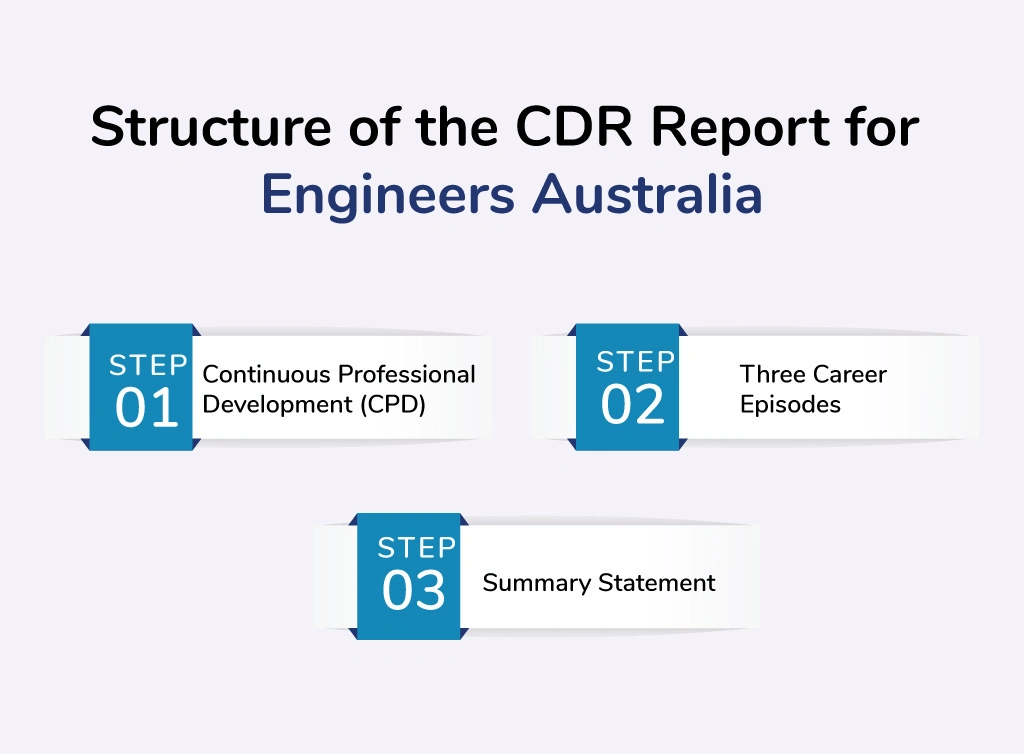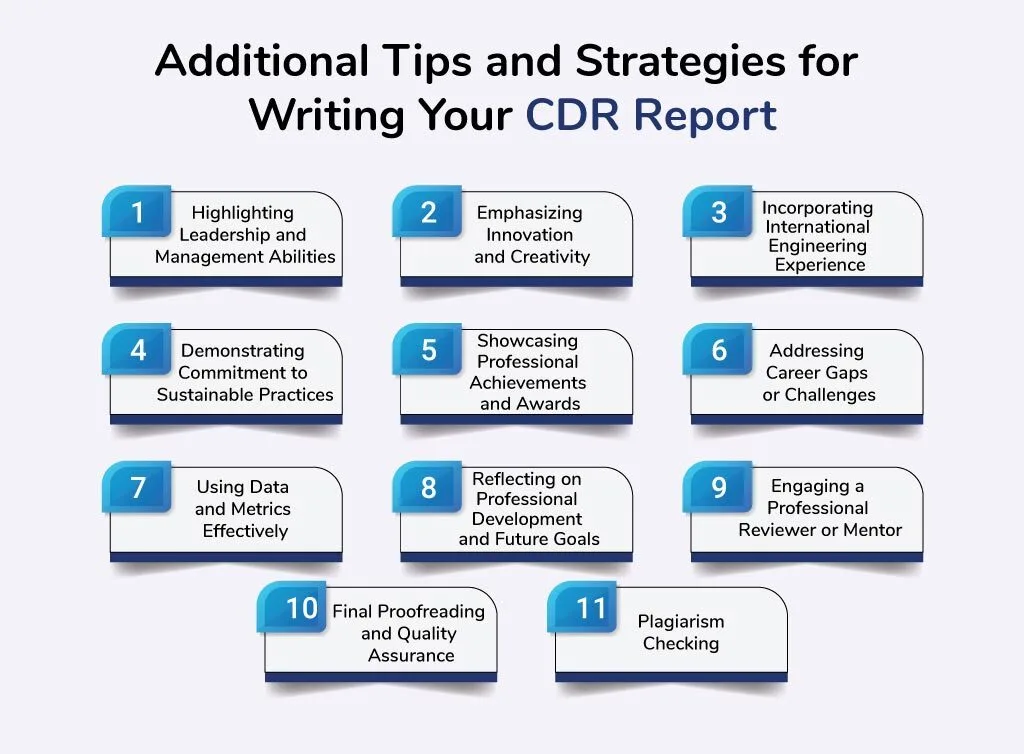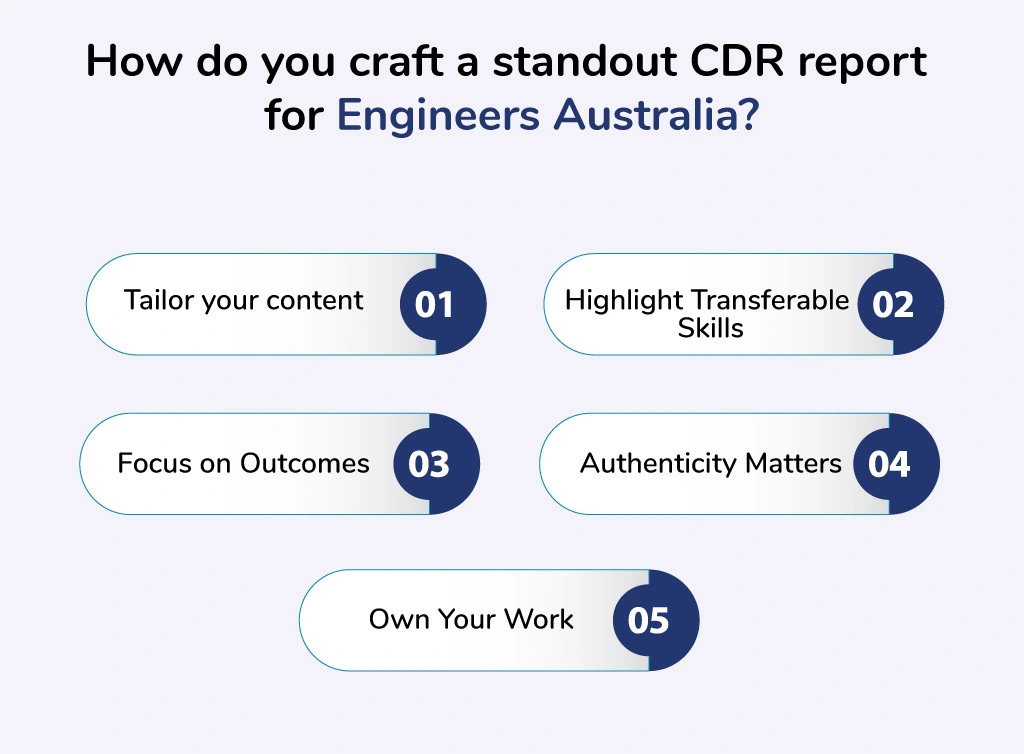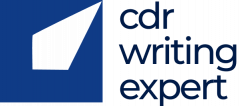
If you’re an engineer looking to migrate to Australia, one of the key requirements you’ll need to fulfill is submitting a Competency Demonstration Report (CDR) to Engineers Australia. This comprehensive report lets you demonstrate your engineering skills and competencies to the assessing body.
In this blog, we’ll guide you through writing an effective CDR report for Engineers Australia, ensuring you meet all the requirements and increasing your chances of a successful assessment.
Understanding the CDR Report for Engineers Australia
What is a CDR Report?
The Competency Demonstration Report (CDR) is a critical document that engineers with non-accredited qualifications or those outside the Washington Accord must submit for migration skills assessment by Engineers Australia.
A CDR (Competency Demonstration Report) is a document required by Engineers Australia from applicants who wish to have their engineering qualifications assessed for migration purposes to Australia that showcase an engineer’s skills, knowledge, and experience in their engineering field.
It includes detailed descriptions of engineering projects, a summary statement linking the Career Episodes to the competency elements, and continuous professional development (CPD) records.
Why is the CDR Report important?
The CDR report is crucial because it is the primary means by which Engineers Australia evaluates whether your engineering qualifications and experience meet Australian standards.
A well-prepared CDR can open the door to a successful career in Australia, while a poorly prepared one can lead to rejection and delay your migration plans.
Preparing to Write Your CDR Report

To prepare a CDR report, you can use the below guidelines:
Understanding the Guidelines
Before you start writing your CDR report, it’s essential to thoroughly understand the guidelines provided by Engineers Australia. These guidelines outline the CDR report’s structure, content, and format. Familiarize yourself with the following key documents:
- Migration Skills Assessment (MSA) Booklet
This booklet provides comprehensive information on the CDR process, including the required documents and assessment criteria.
- Engineers Australia Competency Standards
These standards outline the competencies you need to demonstrate in your CDR.
Gathering Required Documents
Make sure you have all the necessary documents before you start writing your CDR. These typically include:
- Certified copies of your academic transcripts and degrees
- Curriculum Vitae (CV)
- Three career episodes
- Summary statement
- Continuing Professional Development (CPD) list
- English language test results (IELTS, TOEFL, or PTE Academic)
Choosing Your Career Episodes
Your CDR will include three career episodes, each focusing on different aspects of your engineering work. Choose projects or experiences that best demonstrate your skills and competencies. Ensure that each career episode is unique and covers different competency elements.
When selecting your Career Episodes, consider the following:
Relevance
Choose projects that are relevant to the engineering discipline you are applying for.
Significance
Select projects where you had a significant role and made impactful contributions.
Variety
Ensure the three episodes cover a wide range of skills and experiences to showcase your versatility as an engineer.
Planning Your CDR Report
Careful planning is crucial to ensuring your CDR report is comprehensive and well-structured. Start by outlining the key points you want to include in each section of your report.
Create a timeline to manage your writing process, allowing ample time for research, drafting, and revisions.
Understanding the Competency Elements
The Engineers Australia Competency Standards outline the competencies you need to demonstrate in your CDR. These are divided into the following categories:
- Knowledge and Skill Base
Demonstrates your technical knowledge and expertise.
- Engineering Application Ability
It shows your ability to apply engineering principles and techniques.
- Professional and Personal Attributes
Reflects your professional conduct, communication skills, and ethical standards.
Familiarize yourself with these competency elements and consider how your career episodes can demonstrate each one.
Structure of the CDR Report for Engineers Australia

The CDR report consists of several key components, each serving a specific purpose. Let’s explore each component in detail:
- Continuous Professional Development (CPD)
- Three Career Episodes
- Summary Statement
1. Continuous Professional Development (CPD)
The CPD section of your CDR report should include all the activities you have undertaken to keep your engineering knowledge and skills up-to-date. This may include:
- Formal education and training (degrees, courses, workshops)
- Informal learning (reading books, journals, and online resources)
- Conferences and seminars attended
- Membership in professional engineering organizations
- Presentations or lectures delivered
Ensure your CPD list is comprehensive and includes dates, descriptions, and the outcomes of each activity. This section should reflect your commitment to continuous learning and professional growth.
Example of a CPD Record
- Title
Advanced Project Management Course
- Institution
ABC Training Institute
- Date
March 2019
- Description
A comprehensive course covering advanced project management techniques, including risk management, resource allocation, and stakeholder communication.
- Outcome
Enhanced project management skills, resulting in improved efficiency and successful completion of projects within deadlines.
2. Writing the Career Episodes
Each career episode should be a detailed account of a specific engineering project or task you have undertaken. Follow these guidelines to write compelling Career Episodes:
Career Episode Format
Each career episode should be written in an essay format and include the following sections:
1. Introduction
Provide an overview of the career episode, including the dates, duration, location, and name of the organization you were working for.
2. Background
Describe the context of the project, including the objectives, the nature of your work, the organizational structure, and your role.
3. Personal Engineering Activity
This is the most crucial part of your Career Episode. Describe in detail the specific tasks you performed, the technical challenges you faced, and how you applied your engineering knowledge and skills to solve them.
Use the first person (e.g., I designed, I analyzed) to emphasize your contributions.
4. Summary
Summarize the outcomes of the project, including what you achieved and any lessons learned.
Tips for Writing Effective Career Episodes
- Be Specific
Provide detailed descriptions of your work and avoid making general statements. Use technical language and include calculations, designs, or diagrams if necessary.
- Focus on Your Role
Highlight your contributions and responsibilities rather than those of the team or organization.
- Align with Competency Standards
Ensure your career episodes cover the competency elements outlined by Engineers Australia. Use the Engineers Australia Competency Standards as a checklist.
- Use Active Language
Write in the first person and use active verbs to describe your actions and contributions.
Example of a Career Episode
Let’s look at an example of how to structure a career episode:
Introduction
In this career episode, I will describe my role in the design and implementation of a wastewater treatment plant project for XYZ Engineering Ltd. The project was carried out from January 2018 to December 2019 in Melbourne, Australia.
Background
The wastewater treatment plant project aimed to improve the water quality in the local river by treating industrial wastewater. The project involved designing and constructing a new treatment facility, including the installation of advanced filtration systems and chemical treatment processes. I was responsible for the overall design and supervision of the project.
Personal Engineering Activity
During the project, I conducted a thorough analysis of the existing wastewater treatment processes and identified areas for improvement. I designed a new filtration system that incorporated state-of-the-art technology to enhance treatment efficiency.
I also oversaw the construction of the new facility, ensuring that all work was completed to the highest standards of quality and safety. I collaborated closely with the project team, providing technical guidance and support throughout the project.
Summary
The project was completed successfully, and the new treatment plant significantly improved the water quality in the local river. The project was recognized as a major achievement and received positive feedback from the local community and regulatory authorities.
I gained valuable experience in project management and advanced wastewater treatment technologies.
3. Crafting the Summary Statement
The summary statement is a crucial part of your CDR report. It links the competency elements to the specific paragraphs in your career episodes. Follow these steps to write an effective summary statement:
1. Identify Competency Elements
Review the Engineers Australia Competency Standards and identify the elements you have demonstrated in your career episodes.
2. Map Career Episodes to competency elements
Create a table or matrix that maps the paragraphs in your career episodes to the corresponding competency elements. Indicate which paragraphs demonstrate each element.
3. Provide Evidence
In the summary statement, briefly describe how each paragraph in your career episodes demonstrates the corresponding competency element.
In the summary statement, you need to briefly explain how each paragraph demonstrates the corresponding competency element.
Learn More: How to Write CDR for Engineers Australia? 🔥❤️🔥
Tips for a Successful CDR Report for Engineers Australia

Here are a few tips for a successful CDR report for Engineers Australia:
Adhering to Engineers Australia Guidelines
Ensure your CDR report adheres to the guidelines provided by Engineers Australia. Follow the recommended structure, format, and word count for each section. Avoid using jargon or acronyms without an explanation.
Proofreading and Editing
A well-written CDR report should be free of grammatical errors and typos. Proofread your report multiple times, and consider seeking feedback from colleagues or professional editing services. Ensure the language is clear, concise, and professional.
Demonstrating Competencies
Your CDR report should demonstrate your engineering competencies. Use specific examples from your career episodes to highlight your skills and knowledge. Ensure each competency element is adequately covered.
Maintaining Honesty and Integrity
It’s crucial to be honest and accurate in your CDR report. Do not exaggerate your achievements or include false information. Engineers Australia may verify the information provided in your report, and any discrepancies can lead to rejection or further consequences.
Managing Time Effectively
Writing a comprehensive CDR report is a time-consuming process. Plan your time effectively to ensure you can dedicate sufficient time to each section of the report. Set deadlines for each part of the report and stick to them.
This will help you avoid last-minute stress and ensure your report is of high quality.
Seeking Professional Assistance
If you find the CDR report writing process challenging, consider seeking professional assistance. There are various services available that specialize in helping engineers prepare their CDR reports.
These services can provide guidance, feedback, and editing support to ensure your report meets the required standards.
Keeping Up-to-Date with Industry Developments
Continuously update your knowledge and skills by staying informed about the latest developments in your field of engineering. Participate in professional development activities, attend conferences, and read industry publications.
This will not only enhance your CPD section but also demonstrate your commitment to professional growth.
Understanding the Assessment Criteria
Familiarize yourself with the assessment criteria used by Engineers Australia. Understanding what the assessors are looking for will help you tailor your CDR report to meet their expectations. The assessment criteria typically include the following:
- Depth and breadth of knowledge and skills
Demonstrating a comprehensive understanding of your engineering field.
- Application of engineering principles
Showing how you apply theoretical knowledge to practical situations.
- Problem-solving abilities
Highlighting your ability to identify and solve engineering problems.
- Communication skills
Demonstrate your ability to communicate effectively with colleagues, clients, and stakeholders.
- Professionalism and ethics
Reflecting on your commitment to ethical conduct and professional standards.
Highlighting Key Achievements
In your career episodes, highlight key achievements that demonstrate your engineering competencies. Use specific examples and quantify your achievements wherever possible.
For instance, mention the percentage improvement in efficiency, cost savings, or reduction in environmental impact achieved through your projects.
Using Visual Aids
Where appropriate, include diagrams, charts, or other visual aids to enhance your Career Episodes. Visual aids can help illustrate complex technical concepts and make your report more engaging.
Ensure that any visual aids are clearly labeled and referenced in the text.
Tailoring Your Report to Your Engineering Discipline
Tailor your CDR report to your specific engineering discipline. Each engineering discipline has unique requirements and competencies, so ensure your report reflects the specific skills and knowledge relevant to your field.
For example, a civil engineer’s CDR will differ significantly from that of an electrical engineer.
Staying Organized
Keep all your documents and evidence organized throughout the CDR writing process. Create folders for each section of the report and store all relevant documents, such as academic transcripts, project reports, and certificates, systematically.
This will make it easier to compile your report and ensure you don’t miss any important information.
Learn More: Why CDR Report is Important for Australian Migration? 💥💯🎉
Additional Resources to Assist Your CDR Report Development
Engineers Australia Website
The Engineers Australia website is a valuable resource for information on the CDR process, guidelines, and assessment criteria. Regularly check the website for updates and additional resources that can assist you in preparing your CDR report.
Online Forums and Communities
Join online forums and communities where other engineers share their experiences and tips for writing CDR reports. These platforms can provide valuable insights and support from individuals who have completed the CDR process.
Professional CDR Writing Services
Consider using professional CDR writing services if you need expert assistance in preparing your report. These services offer tailored support, including guidance on selecting career episodes, writing and editing your report, and ensuring it meets Engineers Australia’s standards.
Sample CDR Reports
Reviewing sample CDR reports can provide a better understanding of the format, structure, and level of detail required. However, use these samples as a reference only and ensure your report is original and reflects your personal experiences and achievements.
Attending Workshops and Seminars
Look for workshops and seminars specifically focused on the CDR writing process. These events can offer practical advice, step-by-step guidance, and the opportunity to ask questions and receive feedback from experts.
Additional Tips and Strategies for Writing Your CDR Report

Crafting a Competency Demonstration Report (CDR) for Engineers Australia goes beyond meeting basic requirements—it’s about presenting your engineering skills and experiences in the best possible manner.
In addition to the detailed guide provided earlier, here are some extra tips and strategies to help you create a compelling CDR report:
Highlighting Leadership and Management Abilities
When describing your career episodes, emphasize any leadership or managerial roles you’ve held. Engineers Australia values candidates who can demonstrate leadership qualities such as project management, team coordination, and decision-making skills.
Highlight instances where you led teams, managed resources effectively or resolved conflicts to achieve project goals.
Emphasizing Innovation and Creativity
Engineers often need to innovate and find creative solutions to complex problems. Use your career episodes to showcase times when you implemented innovative solutions or introduced new technologies.
Describe how your creative approach contributed to project success, improved efficiency, or solved significant engineering challenges.
Incorporating International Engineering Experience
If you have international engineering experience, highlight this in your CDR report. Engineers Australia values candidates with diverse global perspectives.
Describe how your international assignments or collaborations have enhanced your skills, broadened your understanding of global engineering practices, and prepared you for challenges in the Australian engineering context.
Demonstrating Commitment to Sustainable Practices
Sustainability is increasingly important in engineering. If your projects included sustainable design principles, energy efficiency measures, or environmental impact assessments, feature these prominently in your career episodes.
Engineers Australia appreciates engineers committed to sustainable development and environmental responsibility.
Showcasing Professional Achievements and Awards
Include any awards, recognitions, or commendations for your engineering work. Awards validate your professional achievements and demonstrate your capabilities.
Explain the criteria for receiving the award, the significance of your achievement, and its impact on your career and community.
Addressing Career Gaps or Challenges
Use your CDR report to address any career gaps, challenges, or setbacks you’ve faced. Engineers Australia understands that career paths aren’t always straightforward.
Describe how you navigated challenges, learned from setbacks, and emerged stronger and more competent as an engineer.
Using Data and Metrics Effectively
Quantify your achievements where possible. Use data, metrics, and specific examples to substantiate your claims and demonstrate the impact of your work.
Mention cost savings achieved, efficiency improvements, project timeline reductions, or positive feedback from clients or stakeholders. Concrete evidence enhances your CDR report’s credibility.
Reflecting on Professional Development and Future Goals
In your CPD list and summary statement, reflect on your ongoing professional development activities and future career aspirations. Engineers Australia assessors are interested in your commitment to continuous learning and professional growth.
Describe how your CPD activities have enhanced your skills and knowledge and how they align with your long-term career goals in Australia.
Engaging a Professional Reviewer or Mentor
Consider seeking feedback from a professional reviewer or mentor familiar with the CDR process. Their perspective can provide valuable insights and suggestions for improving your CDR report.
Professional reviewers can also ensure your report meets Engineers Australia’s specific requirements, increasing your chances of a positive assessment outcome.
Final Proofreading and Quality Assurance
Before submitting your CDR report, conduct a final proofreading and quality assurance check. Ensure all sections are coherent, well-structured, and error-free.
Verify that you’ve followed formatting guidelines, included all required documents, and addressed all competency elements as per Engineers Australia’s requirements. A polished and meticulously prepared CDR report reflects your professionalism and commitment to excellence.
Plagiarism Checking
Check for any plagiarism and Review them to solve it if any error occurs. Also, if needed, contact an expert for a more detailed review.
How do you craft a standout CDR report for Engineers Australia?

While following the standard format is crucial, excelling in your CDR report requires going beyond the bare minimum. Here are some additional tips:
- Tailor your content
Ensure your career episodes align with the specific requirements of your nominated occupation. Use relevant engineering terminology and demonstrate competency in areas critical to your chosen field.
- Highlight Transferable Skills
Showcase not just technical skills but also your communication, teamwork, problem-solving, and project management abilities.
- Focus on Outcomes
Don’t just describe your activities; focus on the tangible results and positive outcomes achieved through your contributions.
- Authenticity Matters
Your report should be a genuine reflection of your engineering expertise and experience. Avoid excessive jargon or fabricated scenarios.
- Own Your Work
Be confident in your skills and achievements. Demonstrate initiative, leadership, and a professional work ethic.
Conclusion
Writing an effective CDR report for Engineers Australia is a meticulous process that requires careful planning, detailed writing, and thorough proofreading.
By following the guidelines provided in this blog, you can create a compelling CDR report that showcases your engineering skills and competencies, increasing your chances of a successful assessment.
Remember, a well-prepared CDR is your gateway to a rewarding engineering career in Australia. Seize the opportunity and demonstrate your professional excellence through your CDR report.
FAQs
1. What is a CDR report?
A Competency Demonstration Report (CDR) is a document required by Engineers Australia to assess the qualifications and competencies of engineers seeking migration to Australia. It includes detailed accounts of the applicant’s engineering education, work experience, and professional development activities.
2. Who needs to submit a CDR report?
Engineers who wish to apply for skilled migration to Australia under the engineering occupations listed in the Skilled Occupation List (SOL) or the Consolidated Sponsored Occupation List (CSOL) must submit a CDR report to Engineers Australia for skills assessment.
3. What are the components of a CDR report?
A CDR report typically consists of the following components:
- Continuing Professional Development (CPD) List
A record of professional development activities undertaken by the applicant.
- Three Career Episodes
Detailed descriptions of specific engineering projects or tasks undertaken by the applicant.
- Summary Statement
A cross-referenced summary links each career episode to the relevant competency elements of Engineers Australia.
4. How many career episodes do I need to include in my CDR report?
You need to include three career episodes in your CDR report. Each career episode should focus on a different aspect of your engineering experience and demonstrate specific competencies as per Engineers Australia’s requirements.
5. What are the competency elements assessed in a CDR report?
The competency elements assessed in a CDR report include:
- Knowledge and Skill Base
Demonstrates your technical knowledge and expertise in your engineering discipline.
- Engineering Application Ability
It shows how you apply engineering principles to practical situations.
- Professional and personal attributes
Reflect on your communication skills, teamwork, and ethical conduct.
6. How do I choose suitable career episodes for my CDR report?
Choose career episodes that best showcase your engineering skills and competencies. Select projects where you played a significant role, contributed to solving engineering problems and demonstrated a range of competencies relevant to your engineering discipline.
7. What format should I use for writing career episodes?
Each career episode should be written in essay format and include sections such as introduction, background, personal engineering activity, and summary. Use clear, concise language, and focus on your contributions and achievements within the project.

